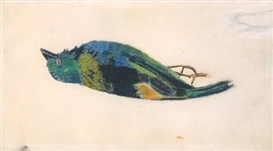As a dramatist, he lacked all the essentials (as did so many would-be playwright poets of the Romantic period) - but the best of his lyrics are something else, something quite unique. Edmund Gosse, in the preface to his 1890 edition of Beddoes' works, puts it like this: 'At the feast of the muses he appears bearing little except one small savoury dish, some cold preparation, we may say, of olives and anchovies, the strangeness of which has to make up for its lack of importance. Not every palate enjoys this hors d'oeuvre, and when that is the case, Beddoes retires; he has nothing else to give. He appeals to a few literary epicures, who, however, would deplore the absence of this oddly flavoured dish as much as that of any more important piece de resistance.' Ezra Pound talks of Beddoes in terms of 'a mass of algae and pearls' and 'the odour of eucalyptus or sea wrack'...
This is his best-known, most anthologised lyric, a thing of seamless perfection:
Dream-Pedlary
i
If there were dreams to sell,
What would you buy?
Some cost a passing bell;
Some a light sigh,
That shakes from Life's fresh crown
Only a roseleaf down.
If there were dreams to sell,
Merry and sad to tell,
And the crier rung the bell,
What would you buy?
ii
A cottage lone and still,
With bowers nigh,
Shadowy, my woes to still,
Until I die.
Such pearl from Life's fresh crown
Fain would I shake me down.
Were dreams to have at will,
This would best heal my ill,
This I would buy.
iii
But there were dreams to sell,
Ill didst thou buy;
Life is a dream, they tell,
Waking, to die.
Dreaming a dream to prize,
Is wishing ghosts to rise;
And, if I had the spell
To call the buried, well,
Which one would I?
iv
If there are ghosts to raise,
What shall I call,
Out of hell's murky haze,
Heaven's blue hall?
Raise my loved longlost boy
To lead me to his joy,
There are no ghosts to raise;
Out of death lead no ways;
Vain is the call.
v
Know'st thou not ghosts to sue?
No love thou hast.
Else lie, as I will do,
And breathe thy last.
So out of Life's fresh crown
Fall like a rose-leaf down.
Thus are the ghosts to woo;
Thus are all dreams made true,
Ever to last!
Here is Beddoes in livelier, but more macabre mode:
Old Adam, the carrion crow,
The old crow of Cairo;
He sat in the shower, and let it flow
Under his tail and over his crest;
And through every feather
Leak'd the wet weather;
And the bough swung under his nest;
For his beak it was heavy with marrow.
Is that the wind dying? O no;
It's only two devils, that blow,
Through a murderer's bones, to and fro,
In the ghosts' moonshine.
Ho! Eve, my grey carrion wife,
When we have supped on king's marrow,
Where shall we drink and make merry our life?
Our nest it is queen Cleopatra's skull,
'Tis cloven and crack'd,
And batter'd and hack'd,
But with tears of blue eyes it is full:
Let us drink then, my raven of Cairo!
Is that the wind dying? O no;
It's only two devils, that blow
Through a murderer's bones, to and fro,
In the ghosts' moonshine.
Here is one of Beddoes' favourite forms - a 'dirge':
If thou wilt ease thine heart
Of love and all its smart,
Then sleep, dear, sleep;
And not a sorrow
Hang any tear on your eye-lashes;
Lie still and deep,
Sad soul, until the sea-wave washes
The rim o’ the sun to-morrow,
In eastern sky.
But wilt thou cure thine heart
Of love and all its smart,
Then die, dear, die;
’T is deeper, sweeter,
Than on a rose bank to lie dreaming
With folded eye;
And then alone, amid the beaming
Of love’s stars, thou ’lt meet her
In eastern sky.
And here's another dirge celebrating the romantic allure of death:
We do lie beneath the grass
In the moonlight, in the shade
Of the yew-tree. They that pass
Hear us not. We are afraid
They would envy our delight,
In our graves by glow-worm night.
Come follow us, and smile as we;
We sail to the rock in the ancient waves,
Where the snow falls by thousands into the sea,
And the drowned and the shipwrecked have happy graves.
Finally, one more - an exquisite lyric that might have come straight from a Jacobean (even a Shakespearean) drama:
The swallow leaves her nest,
The soul my weary breast;
But therefore let the rain
On my grave
Fall pure; for why complain?
Since both will come again
O'er the wave.
The wind dead leaves and snow
Doth hurry to and fro;
And, once, a day shall break
O'er the wave,
When a storm of ghosts shall shake
The dead, until they wake
In the grave.
The death-loving Beddoes took his own life (with poison) in Basel, at the age of 45, having written the same day to his executor, Revell Phillips: 'I am food for what I am good for - worms.'
Doth hurry to and fro;
And, once, a day shall break
O'er the wave,
When a storm of ghosts shall shake
The dead, until they wake
In the grave.
The death-loving Beddoes took his own life (with poison) in Basel, at the age of 45, having written the same day to his executor, Revell Phillips: 'I am food for what I am good for - worms.'









